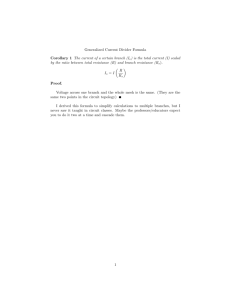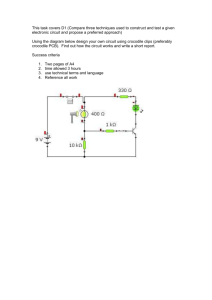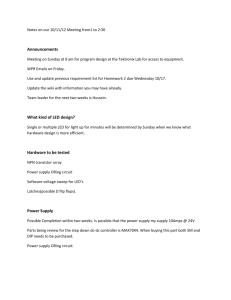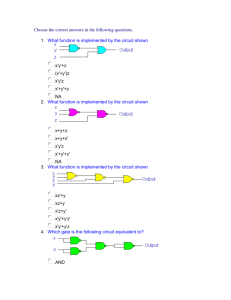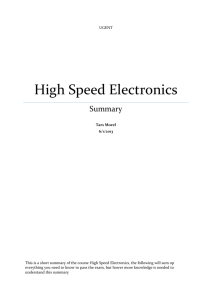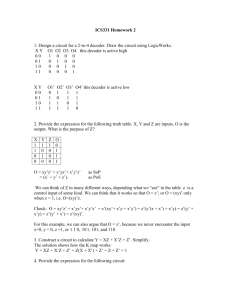Electrical Two-ports; A Maple Approach Amir H. Khanshan
advertisement
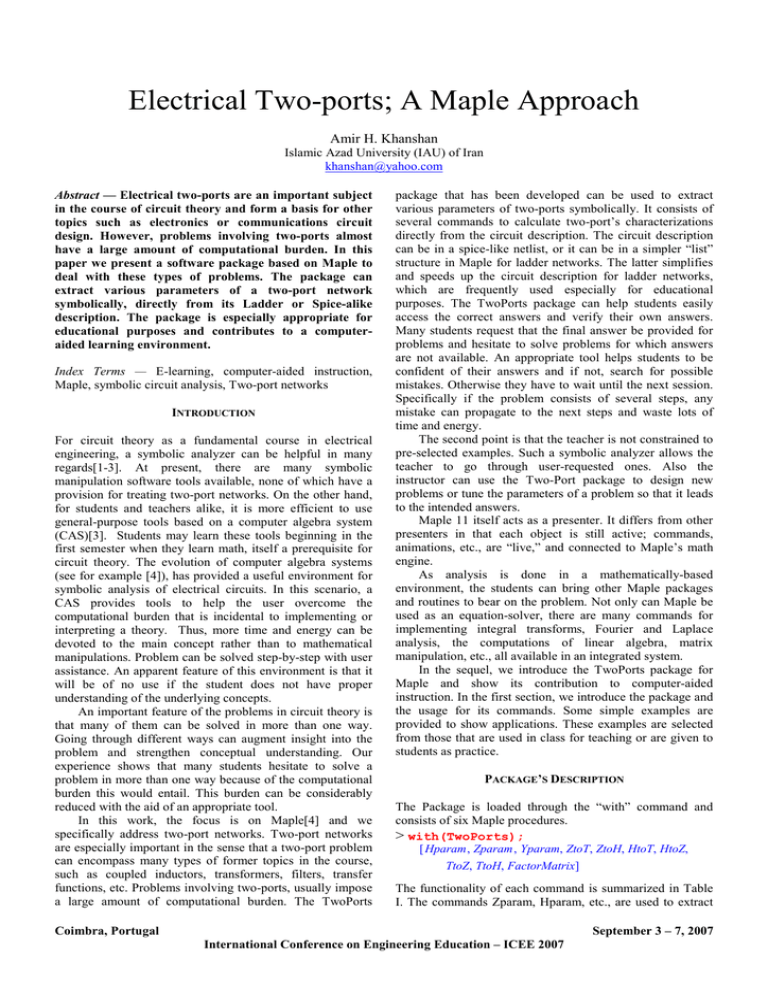
Electrical Two-ports; A Maple Approach
Amir H. Khanshan
Islamic Azad University (IAU) of Iran
khanshan@yahoo.com
Abstract — Electrical two-ports are an important subject
in the course of circuit theory and form a basis for other
topics such as electronics or communications circuit
design. However, problems involving two-ports almost
have a large amount of computational burden. In this
paper we present a software package based on Maple to
deal with these types of problems. The package can
extract various parameters of a two-port network
symbolically, directly from its Ladder or Spice-alike
description. The package is especially appropriate for
educational purposes and contributes to a computeraided learning environment.
Index Terms — E-learning, computer-aided instruction,
Maple, symbolic circuit analysis, Two-port networks
INTRODUCTION
For circuit theory as a fundamental course in electrical
engineering, a symbolic analyzer can be helpful in many
regards[1-3]. At present, there are many symbolic
manipulation software tools available, none of which have a
provision for treating two-port networks. On the other hand,
for students and teachers alike, it is more efficient to use
general-purpose tools based on a computer algebra system
(CAS)[3]. Students may learn these tools beginning in the
first semester when they learn math, itself a prerequisite for
circuit theory. The evolution of computer algebra systems
(see for example [4]), has provided a useful environment for
symbolic analysis of electrical circuits. In this scenario, a
CAS provides tools to help the user overcome the
computational burden that is incidental to implementing or
interpreting a theory. Thus, more time and energy can be
devoted to the main concept rather than to mathematical
manipulations. Problem can be solved step-by-step with user
assistance. An apparent feature of this environment is that it
will be of no use if the student does not have proper
understanding of the underlying concepts.
An important feature of the problems in circuit theory is
that many of them can be solved in more than one way.
Going through different ways can augment insight into the
problem and strengthen conceptual understanding. Our
experience shows that many students hesitate to solve a
problem in more than one way because of the computational
burden this would entail. This burden can be considerably
reduced with the aid of an appropriate tool.
In this work, the focus is on Maple[4] and we
specifically address two-port networks. Two-port networks
are especially important in the sense that a two-port problem
can encompass many types of former topics in the course,
such as coupled inductors, transformers, filters, transfer
functions, etc. Problems involving two-ports, usually impose
a large amount of computational burden. The TwoPorts
package that has been developed can be used to extract
various parameters of two-ports symbolically. It consists of
several commands to calculate two-port’s characterizations
directly from the circuit description. The circuit description
can be in a spice-like netlist, or it can be in a simpler “list”
structure in Maple for ladder networks. The latter simplifies
and speeds up the circuit description for ladder networks,
which are frequently used especially for educational
purposes. The TwoPorts package can help students easily
access the correct answers and verify their own answers.
Many students request that the final answer be provided for
problems and hesitate to solve problems for which answers
are not available. An appropriate tool helps students to be
confident of their answers and if not, search for possible
mistakes. Otherwise they have to wait until the next session.
Specifically if the problem consists of several steps, any
mistake can propagate to the next steps and waste lots of
time and energy.
The second point is that the teacher is not constrained to
pre-selected examples. Such a symbolic analyzer allows the
teacher to go through user-requested ones. Also the
instructor can use the Two-Port package to design new
problems or tune the parameters of a problem so that it leads
to the intended answers.
Maple 11 itself acts as a presenter. It differs from other
presenters in that each object is still active; commands,
animations, etc., are “live,” and connected to Maple’s math
engine.
As analysis is done in a mathematically-based
environment, the students can bring other Maple packages
and routines to bear on the problem. Not only can Maple be
used as an equation-solver, there are many commands for
implementing integral transforms, Fourier and Laplace
analysis, the computations of linear algebra, matrix
manipulation, etc., all available in an integrated system.
In the sequel, we introduce the TwoPorts package for
Maple and show its contribution to computer-aided
instruction. In the first section, we introduce the package and
the usage for its commands. Some simple examples are
provided to show applications. These examples are selected
from those that are used in class for teaching or are given to
students as practice.
PACKAGE’S DESCRIPTION
The Package is loaded through the “with” command and
consists of six Maple procedures.
> with(TwoPorts);
[ Hparam , Zparam , Yparam, ZtoT, ZtoH, HtoT, HtoZ,
TtoZ, TtoH, FactorMatrix]
The functionality of each command is summarized in Table
I. The commands Zparam, Hparam, etc., are used to extract
Coimbra, Portugal
September 3 – 7, 2007
International Conference on Engineering Education – ICEE 2007
the parameters of the network symbolically. The parameters
are returned as a Matrix (not matrix, note the difference
between Matrix and matrix in Maple, see [8]). The usage is
as follows:
> Zparam(NET, a,b,c,d);
where NET is the name of the network described in either
Ladder or Spice-like format [4]. The letters a and b
represent input or primary port nodes and c and d represent
output or secondary ports of the network. The order is
important as the first node represents the positive voltage.
Example 1 elaborates the application.
Command
Zparam
Hparam
HtoZ
HtoT
ZtoH
ZtoT
TtoZ
TABLE I
POINT SIZES AND TYPE STYLES
Description
Return open circuit Impedance parameters
Return Hybrid parameters
Converting Hybrid to Impedance parameters
Converting Hybrid to Transmission parameters
Converting Hybrid to Impedance parameters
Converting Hybrid to Impedance parameters
Converting Hybrid to Impedance parameters
Converting Hybrid to Impedance parameters
Example 1. Suppose a simple Π network is given by Figure
I. The Network can be simply described in ladder form as :
> N:=[0,R1,R3,R2]:
The draw command can be used to generate a descent graph
of the ladder network:
> draw(N);
1
R1
2
R2
R3
FIGURE I
A SIMPLE Π NETWORK FOR EXAMPLE 1.
It warns the user of any possible mistake in circuit
description. Also, it helps to find the node numbering. Then
the Z parameters are easily obtained via:
> Zparam(N,1,0,3,0);
R1 + R3
R3
R3
R3 + R2
b
Cµ
rπ
+
vπ
−
Cπ
e
g mv π
ro
FIGURE II
EQUIVALENT CIRCUIT FOR A BJT BASED ON Π MODEL
These parameters can be converted to hybrid parameters
by ZtoH and to transmission parameters by ZtoT. The Ymatrix can be obtained by inverting the Z-matrix. Symbolic
use of each of these procedures would result in the
conversion formula. For example:
> Z:=<<z11 | z12> , <z21 | z22>>;
z11
Z :=
z21
> ZtoH(Z);
z12
z22
z11 z22 − z12 z21
z22
z21
−
z22
z12
z22
1
z22
This simple example shows how the extraction of these
parameters might be simple and efficient.
Example 2. As a little more complex network, consider
Figure II, which is the equivalent model for a Bipolar
Junction Transistor (BJT). As the network has a ladder
structure, it can be defined as:
> BJT:=[C[pi],[R(r[pi]),C[mu],
G(1,0,g[m])],Ro]:
or
> BJT2:=[C[pi]&//R(r[pi]),C[mu],
G(1,0,g[m])&//Ro]:
which are identical, but generate different schematics under
draw. The hybrid parameters obtained by Hparam are
shown in the bottom of the page. FactorMatix is simply
used to extract the common factors of the entries. Using
indexed names generates the response in the format that is
popular in textbooks and hand-written materials. This is an
important feature, helping students avoid having to
concentrate on relating symbols.
> H:=simplify(Hparam(BJT,1,0,2,0));
rπ
rπ s Cµ
sC r +1+sC r
s
C
r
+
1
+
s
C
r
π π
µ π
π π
µ π
H :=
2
rπ ( s Cµ − gm )
Ro s Cµ Cπ rπ + s Cµ Ro + s Cπ rπ + 1 + s Cµ rπ + gm Ro s Cµ rπ
−
s C r + 1 + s C r
Ro
(
s
C
r
+
1
+
s
C
r
)
π
π
µ
π
π
π
µ
π
> FactorMatrix(H);
rπ
s Cµ rπ
1
&*
rπ Ro gm s Cµ + s Cπ rπ + s Cµ rπ + 1 + s2 Cµ Ro Cπ rπ + s Cµ Ro
s Cπ rπ + s Cµ rπ + 1
−r ( s C − g )
π
µ
m
Ro
Coimbra, Portugal
September 3 – 7, 2007
International Conference on Engineering Education – ICEE 2007
A specific parameter can be extracted easily. For
example hfe of the transistor based on the model in
Example 2 is
> h[fe]=H[2,1];
rπ ( −gm + s Cµ )
hfe = −
s Cµ rπ + 1 + s Cπ rπ
A very simple model can be adopted when we omit
Cµ, Cπ and RO. This can be done directly by setting the
value 0 for capacitors and “infinity” for RO. In Maple,
“infinity” is a symbol that states the mathematical infinity.
> BJT:=[C[pi](0),[R(r[pi]),C[mu](0),
G(1,0,g[m])],Ro(infinity)]:
> H:=simplify(Hparam(BJT,1,0,2,0));
syrup:
There may be an unconnected component.
The following component(s) have zero current:
{Ro, `C[mu]`, `C[pi]`}.
rπ
H :=
rπ gm
0
0
The returned text preceding the response is a warning,
not an error. It helps the user to detect any possible cut-off
in the circuit due to mistyping.
It should be mentioned that direct insertion of infinity
is not identical to taking the limit and in some cases may
lead to incorrect results. The better solution is simply to
omit RO from the list.
Example 3. ∆-Y transformation
A Y circuit may be considered as a T network, and a ∆
circuit may be considered as a Π network. Define:
> N[T]:=[0,R1,R2,R3];
> N[Delta]:=[Ra,Rb,Rc]:
For which have the Z characterizations are:
> Z1:=Zparam(N[T],1,0,3,0);
R2 + R1
R2
Z1 :=
R2
R3
+ R2
> Z2:=Zparam(N[Delta],1,0,2,0);
Ra Rc
Ra ( Rb + Rc )
Rb + Ra + Rc Rb + Ra + Rc
Z2 :=
Ra Rc
Rc ( Rb + Ra )
Rb + Ra + Rc Rb + Ra + Rc
Comparing these matrices leads to the following
familiar equations:
> solve({Z1[1,1]=Z2[1,1],Z1[1,2]=Z2[1,2]
,Z1[2,1]=Z2[2,1],Z1[2,2]=Z2[2,2]},
{R1,R2,R3});
R1 =
Ra Rb
Ra Rc
Rb Rc
, R2 =
, R3 =
Rc + Rb + Ra
Rc + Rb + Ra
Rc + Rb + Ra
CALCULATING TWO-PORT PARAMETERS IN A STEP-BYSTEP MANNER
For the network shown in Figure III, we want to find
admittance parameters. The main idea is to let the students
formulate the problem and use Maple for manipulating
symbolic expressions. This gives the student a complete
understanding of the analysis process from beginning to
end.
βv
R
I1
+
v
_
R
I3
C
FIGURE III
For this example, inserting two voltage sources at the
ports and writing circuit equations leads to the system of
equations
> eq1:=-V1+R*I1+R*(I1+I3)=0:
> eq2:=-(beta-1)*R*(I1+I3)-V2=0:
> eq3:=V2=(I2-I3)*1/(C*s):
which can be solve as
> solve({eq1,eq2,eq3},{I1,I2,I3});
−V1 + V2 + β V1
β V1 − V1 + 2 V2
I1 =
, I3 = −
,
R ( β − 1)
R (β − 1)
−β V1 + V1 − 2 V2 + R β V2 C s − R V2 C s
I2 =
R (β − 1)
The desired parameters are obtained by arranging the
above equations. The command jacobian in the
linalg package can be used to arrange the equations. In
admittance representation, I1 and I2 are represented by V1
and V2.
> assign(%);
> Y:=linalg[jacobian]([I1,I2],[V1,V2]);
1
1
R
R
(
β
− 1)
Y :=
1 −2 + R β C s − R C s
−
R
R (β − 1)
Rearranging the above equation can lead to other twoport representations. The students can verify the
correctness of their answer by inserting the two simple
commands:
> net:=[0,R,R,E(2,0,beta),C];
> Yparam(net,1,0,3,0):
The network can be defined as
> net:=[0,R,R,V(beta*v[2]),C];
The difference is that the former uses Spice syntax for
representing a dependent source, whereas the latter
replaces it with an independent source with a symbolic
referenced value.
TWO-PORTS CONCATENATION
Consider the circuit in Figure IV, where the two networks
are interconnected in a series-series form. The hybrid
parameters of each netwok are given as
> H1:=<<s | alpha> , <1 | 1>>;
Coimbra, Portugal
September 3 – 7, 2007
International Conference on Engineering Education – ICEE 2007
α
1
s
H1 :=
1
p1
+
I2
I1
h11
> H2:=<<1 | alpha> , <1 | -1>>;
α
-1
1
H2 :=
1
V1
We are supposed to find the impedance parameters of
the augmented network. The students may consider several
ways. One way is to apply two current sources at the ports,
writing KCL or KVL equations and solving them by
solve as we did in the preceding section. Arranging the
equations with jacobian would give the desired matrix.
Another idea is first converting H parameters to Z
parameters and adding them to find the impedance
parameters of the series-series connection. The resulting
two-port is in parallel (shunt-shunt configuration[5]) with
a network containing R1, R2, C. Thus, the Z matrix is
inverted to obtain Y and added to Y-matrix of the second
two-port. The resultant Y-matrix is inverted to yield the Zmatrix of the overall network.
> Z1:=HtoZ(H1);
> Z2:=HtoZ(H2);
s−α
Z1 :=
-1
α
1
1+α
Z2 :=
1
−α
-1
> Z1+Z2;
s + 1
0
pm
h21I1
V2
1/h22
h12V2
_
p2
_
s2
FIGURE V
EQUIVALENT MODEL FOR A TWO-PORT BASED ON HYBRID
CHARACTERIZATION
Zi
FIGURE VI
Using TwoPort, the problem can be solved as follows.
0
0
In fact, the above network is identical to the network
in Figure VI in which Zi=1+s. This is a network that does
not have any other characterizations. Its impedance matrix
can be found by Zparam([R],1,0,0,0). Since the
output nodes are short-circuited, C, R1 and R2 are in
parallel with Zi=1+s, resulting in Zi=1/2Ω.
> Ex:="Series Concatenation
R1 1 0 1
C 1 2 1
X1 1 4 2 3 HE(h11=s,h12=alpha,h21=1,h22=1)
X2 4 0 3 5 HE(h11=1,h12=alpha,h21=1,h22=-1)
R2 0 5 1
.subckt HE p1 p2 s1 s2
R1 p1 pm h11
V1 pm p2 h12*(v[s1]-v[s2])
R2 s1 s2 1/h22
I2 s1 s2 h21*i[V1]
.ends
.end":
The sub-circuit HE defines a two-port based on its
hybrid equivalent model as shown in Figure V. The
parameters are defined symbolically and can be valued
when referenced in parentheses after the name HE.
The impedance parameters of the extended circuit are:
> Zparam(Ex,1,0,2,5);
C
N2
R2
FIGURE IV
parsedeck:
Analyzing SPICE deck "Series
Concatination" (ignoring this line)
1
0
2
0
0
To see if the series-series connection of N1 and N2 is
a two-port, two transformers can be set to isolate these
two-ports at the output. Ideal transformers can be defined
in the netlist by their hybrid representation and no extra
subcircuit is needed.
N1
R1
s1
+
IDEAL OPAMPS
In numerical analyzers, an ideal Opamp is approximated
with a voltage-controlled voltage source (VCVS) with a
high gain. In a symbolic environment, the response can be
found as a function of Opamp gain (A) by taking limit as
Coimbra, Portugal
September 3 – 7, 2007
International Conference on Engineering Education – ICEE 2007
A approaches infinity[7]. Figure VII shows a two-port
network with an Opamp in it. The network is represented
as:
> P:="
Rf 1 3 R
R1 1 0 R
RL 3 2 R
X 2 1 3 opamp
.subckt opamp noninv inv out
V out 0 A*(v[noninv]-v[inv])
.ends
.end":
ACKNOWLEDGMENT
The author would like to greatly appreciate Professor
Robert J. Lopez for his valuable comments.
REFERENCES
[1]
A. I. Beltzer and A. L. Shenkman, “Use of symbolic computation in
engineering education”, IEEE Transactions on Education, vol. 38,
no. 2, pp. 177-184, May 1995.
[2]
L. P. Huelsman, “Symbolic analysis-a tool for teaching
undergraduate circuit theory”, IEEE Transactions on Education,
vol. 39, no. 2, pp. 243-250, May 1996.
[3]
Hemanshu R. Pota, “Computer-Aided Analog Electronics
Teaching”, IEEE Transactions On Education, vol. 40, no. 1,
February 1997.
[4]
Waterloo Maple homepage: http://www.maplesoft.com
[5]
Charles A Desoer & E.S.Kuh , Basic Circuit Theory, McGrawHill,1998.
R
+
V1
−
+
R
V2
[6]
Joseph S. Riel, “Syrup 9 Symbolic Circuit Analysis for Maple 9”,
Proc. Of MSW2004, Waterloo, ON, Canada, July 2004.
R
−
[7]
Amir H. Khanshan, “A Maple approach to electrical engineering
problems”, Proc. Of MSW2004, Waterloo, ON, Canada, July 2004.
[8]
Frank Gravan, “The Maple Book”, Chapman & Hall/CRC, USA,
2002.
FIGURE VII
A TWO-PORT NETWORK WITH AN IDEAL OPAMP.
The impedance parameters can be obtained through
> Z:=Zparam(p36,1,2,3,0);
If Opamp is considered to be ideal, the Z-parameters
are
> Z1:=map(limit,Z,A=infinity);
0
Z1 :=
3
R
0
0
Transmission parameters can be obtained by ZtoT.
But this network does not have other characterizations.
CONCLUSION
With the growth in the course content of electrical
engineering degree programs, traditional pedagogies
should be superseded by computer-aided ones. New
educational systems such as e-learning or distance learning
are also demanded by these trends. From an educational
point of view, it is more efficient for both students and
instructors to use general-purpose tools that can be used in
different courses. In this paper, we addressed two-port
characterization, an important topic in the course of circuit
theory and showed how Maple can be used for symbolic
manipulation of a prototype problem regarding two-port
networks in a step-by-step manner. We also introduced the
TwoPorts package, which provides tools for symbolic
extraction of two-ports’ parameters. The package can be
seen as a useful contribution to a computer-aided learning.
Coimbra, Portugal
September 3 – 7, 2007
International Conference on Engineering Education – ICEE 2007

